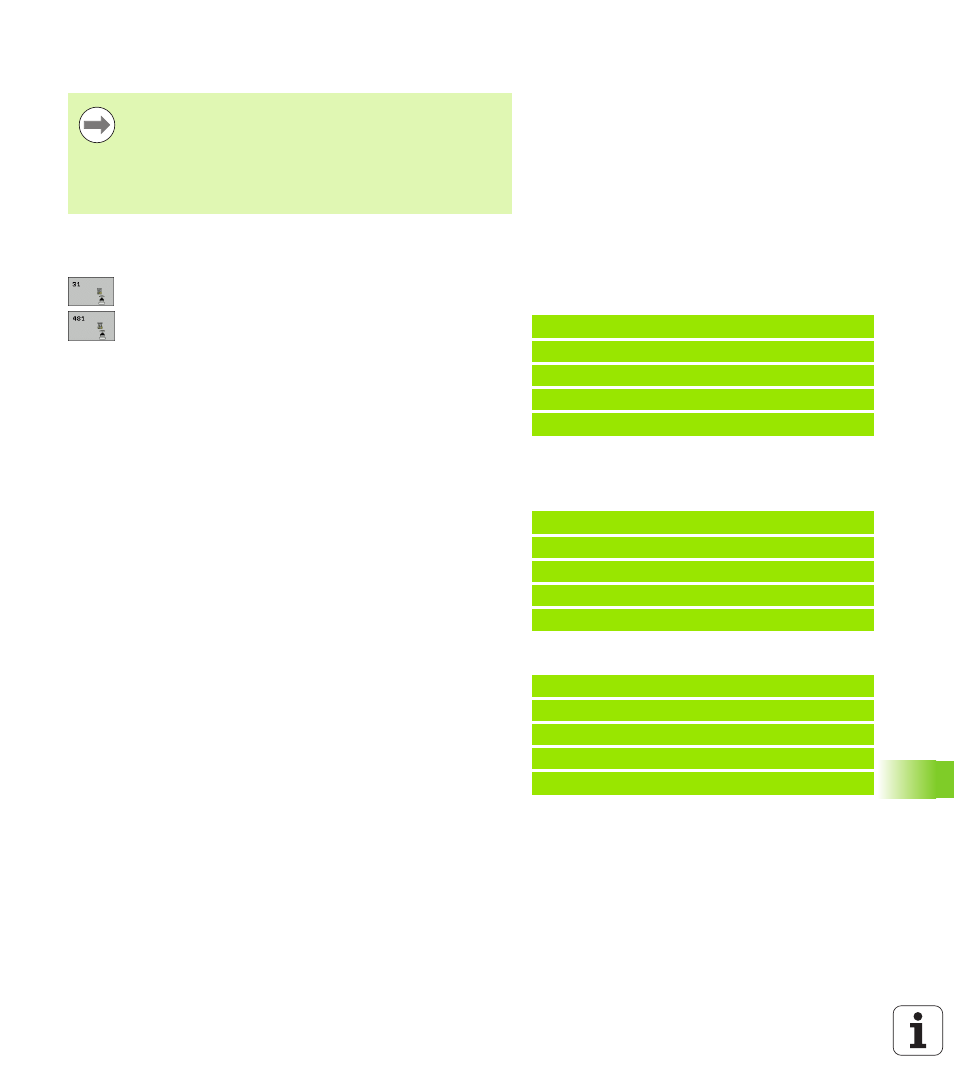Please note while programming, Cycle parameters – HEIDENHAIN TNC 320 (340 55x-04) Cycle programming User Manual
Page 425

HEIDENHAIN TNC 320
425
1
8
.3 Measur
ing the T
ool Length
(Cy
c
le 31 or 481, DIN/ISO: G481)
Please note while programming:
Cycle parameters
U
Measure tool=0 / Check tool=1:
Select whether the
tool is to be measured for the first time or whether a
tool that has already been measured is to be
inspected. If the tool is being measured for the first
time, the TNC overwrites the tool length L in the
central tool file TOOL.T by the delta value DL = 0. If
you wish to inspect a tool, the TNC compares the
measured length with the tool length L that is stored
in TOOL.T. It then calculates the positive or negative
deviation from the stored value and enters it into
TOOL.T as the delta value DL. The deviation can also
be used for Q parameter Q115. If the delta value is
greater than the permissible tool length tolerance for
wear or break detection, the TNC will lock the tool
(status L in TOOL.T).
U
Parameter number for result?:
Parameter number in
which the TNC stores the status of the
measurement:
0.0: Tool is within the tolerance
1.0: Tool is worn (LTOL exceeded)
2.0: Tool is broken (LBREAK exceeded). If you do not
wish to use the result of measurement within the
program, answer the dialog prompt with NO ENT.
U
Clearance height:
Enter the position in the spindle
axis at which there is no danger of collision with the
workpiece or fixtures. The clearance height is
referenced to the active workpiece datum. If you
enter such a small clearance height that the tool tip
would lie below the level of the probe contact, the
TNC automatically positions the tool above the level
of the probe contact (safety zone from
safetyDistStylus
). Input range –99999.9999 to
99999.9999
U
Cutter measurement? 0=No / 1=Yes:
Choose whether
the control is to measure the individual teeth
(maximum of 20 teeth)
Before measuring a tool for the first time, enter the
following data on the tool into the tool table TOOL.T: the
approximate radius, the approximate length, the number
of teeth, and the cutting direction.
You can run an individual tooth measurement of tools with
up to 20 teeth.
Example: Measuring a rotating tool for the first
time; old format
6 TOOL CALL 12 Z
7 TCH PROBE 31.0 TOOL LENGTH
8 TCH PROBE 31.1 CHECK: 0
9 TCH PROBE 31.2 HEIGHT: +120
10 TCH PROBE 31.3 PROBING THE TEETH: 0
Example: Inspecting a tool and measuring the
individual teeth and saving the status in Q5; old
format
6 TOOL CALL 12 Z
7 TCH PROBE 31.0 TOOL LENGTH
8 TCH PROBE 31.1 CHECK: 1 Q5
9 TCH PROBE 31.2 HEIGHT: +120
10 TCH PROBE 31.3 PROBING THE TEETH: 1
Example: NC blocks in new format
6 TOOL CALL 12 Z
7 TCH PROBE 481 TOOL LENGTH
Q340=1
;CHECK
Q260=+100 ;CLEARANCE HEIGHT
Q341=1
;PROBING THE TEETH